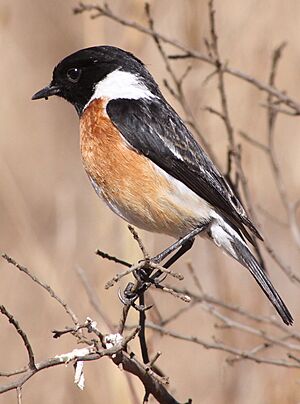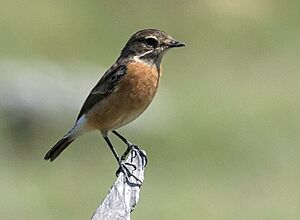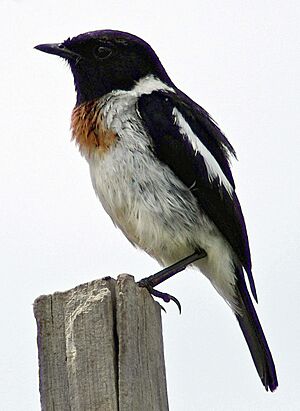African stonechat facts for kids
Quick facts for kids African stonechat |
|
|---|---|
 |
|
| Adult male in South Africa | |
 |
|
| Adult female in Botswana | |
| Conservation status | |
| Scientific classification | |
| Subspecies | |
|
13-17 subspecies |
|
| Synonyms | |
|

The African stonechat (Saxicola torquatus) is a small bird found across sub-Saharan Africa. It belongs to the Old World flycatcher family, which includes many types of small, insect-eating birds. For a long time, people thought these birds were part of the thrush family, but scientists now know they are different.
The scientific name of this bird, Saxicola torquatus, tells us a bit about it. Saxicola comes from Latin words meaning "rock-dweller," because it often lives near rocks. Torquatus means "collared," which refers to the white collar-like marking on its neck.
In the past, the name S. torquatus was used for a larger group of similar birds. However, scientists now consider the African stonechat a separate species. Other related birds, like the European stonechat and Siberian stonechat, are also their own distinct species.
Contents
About the African Stonechat
The African stonechat was first described in detail by a French zoologist named Mathurin Jacques Brisson in 1760. He studied a bird from the Cape of Good Hope in South Africa. Later, in 1766, the famous Swedish naturalist Carl Linnaeus gave the bird its official scientific name, Muscicapa torquata. Today, it is placed in the Saxicola group of birds.
Scientists believe the African stonechat's closest relative is the Réunion stonechat. These two species are part of a group of stonechats that live in Africa. They separated from their Eurasian relatives about 2.5 million years ago. This happened as the Sahara desert became drier, which created a natural barrier between the African and Eurasian bird populations.
African Stonechat Subspecies
There are 13 different types, or subspecies, of the African stonechat. These subspecies are very similar but have small differences. They can vary a little in size. Males often have different amounts of orange-red on their chests. Some have a clear line between the orange and white parts of their belly, while others have a more blended color. The amount of orange-red can also change depending on the time of year.
Here are some of the recognized subspecies:
- S. t. felix – found in southwest Saudi Arabia and west Yemen.
- S. t. albofasciatus – found from southeast Sudan to central Ethiopia. Its upper breast is black, not orange-red.
- S. t. jebelmarrae – found in east Chad and west Sudan.
- S. t. moptanus – found in Senegal and south Mali. This is the smallest subspecies.
- S. t. nebularum – found in West Africa, from Sierra Leone to west Ivory Coast. It has a lot of orange-red on its breast and sides.
- S. t. axillaris – found in east Democratic Republic of the Congo, Kenya, and parts of Tanzania.
- S. t. promiscuus – found from south Tanzania to east Zimbabwe. It has very little orange-red on its breast.
- S. t. salax – found from east Nigeria to northwest Angola.
- S. t. stonei – found from east and south Angola to north South Africa.
- S. t. clanceyi – found along the coast of west South Africa.
- S. t. torquatus – found in central South Africa.
- S. t. oreobates – found in Lesotho.
- S. t. voeltzkowi – found on Grande Comore island.
What the African Stonechat Looks Like
Male African stonechats are quite striking. They have a black head, a white half-collar around their neck, a black back, and a white rump (the area above the tail). Their tail is black, and their wings are black with a large white patch on the inside. The upper part of their chest is usually a dark orange-red. This color can either sharply change to white or pale orange on their lower chest and belly, or it can blend gradually, depending on the subspecies. In some rare cases, the orange breast feathers can be partly or entirely black.
Female African stonechats look a bit different. They are mostly brown on their head and back, instead of black. They have a faint, lighter line above their eyes. Their underside is a chestnut-buff color, not orange. They also have less white on their wings compared to the males. Both male and female birds have duller and streakier feathers when it's not the breeding season.
Where the African Stonechat Lives
The African stonechat is found in many scattered areas across sub-Saharan Africa. You can see them as far north as Senegal and Ethiopia. There are also populations in the mountains of southwest Arabia, on the island of Madagascar, and on Grande Comore.
These birds do not migrate long distances. They usually stay in the same area, or only move a short distance if needed. Because they don't travel far, different groups of stonechats have developed unique traits over time, leading to the many subspecies we see today.


